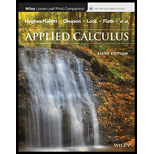
APPLIED CALCULUS-PRINT COMPANION (LL)
6th Edition
ISBN: 9781119275565
Author: Hughes-Hallett
Publisher: WILEY
expand_more
expand_more
format_list_bulleted
Question
Chapter 7, Problem 5SYU
To determine
To indicate that the statement “If p(x) is a density function for age in years of the US population, then
Expert Solution & Answer
Want to see the full answer?
Check out a sample textbook solution
Students have asked these similar questions
Pls help ASAP
Pls help ASAP
9. a) Determie values of a and b so that the function is continuous.
ax - 2b
f(x)
2
x≤-2
-2x+a, x ≥2
\-ax² - bx + 1, −2 < x < 2)
9b) Consider f(x):
=
2x²+x-3
x-b
and determine all the values of b such that f(x) does
not have a vertical asymptote. Show work.
Chapter 7 Solutions
APPLIED CALCULUS-PRINT COMPANION (LL)
Ch. 7.1 - Prob. 1PCh. 7.1 - Prob. 2PCh. 7.1 - Prob. 3PCh. 7.1 - Prob. 4PCh. 7.1 - Prob. 5PCh. 7.1 - Prob. 6PCh. 7.1 - Prob. 7PCh. 7.1 - Prob. 8PCh. 7.1 - Prob. 9PCh. 7.1 - Prob. 10P
Ch. 7.1 - Prob. 11PCh. 7.1 - Prob. 12PCh. 7.1 - Prob. 13PCh. 7.1 - Prob. 14PCh. 7.1 - Prob. 15PCh. 7.1 - Prob. 16PCh. 7.1 - Prob. 17PCh. 7.1 - Prob. 18PCh. 7.2 - Prob. 1PCh. 7.2 - Prob. 2PCh. 7.2 - Prob. 3PCh. 7.2 - Prob. 4PCh. 7.2 - Prob. 5PCh. 7.2 - Prob. 6PCh. 7.2 - Prob. 7PCh. 7.2 - Prob. 8PCh. 7.2 - Prob. 9PCh. 7.2 - Prob. 10PCh. 7.2 - Prob. 11PCh. 7.2 - Prob. 12PCh. 7.2 - Prob. 13PCh. 7.2 - Prob. 14PCh. 7.2 - Prob. 15PCh. 7.2 - Prob. 16PCh. 7.2 - Prob. 17PCh. 7.2 - Prob. 18PCh. 7.2 - Prob. 19PCh. 7.2 - Prob. 20PCh. 7.2 - Prob. 21PCh. 7.3 - Prob. 1PCh. 7.3 - Prob. 2PCh. 7.3 - Prob. 3PCh. 7.3 - Prob. 4PCh. 7.3 - Prob. 5PCh. 7.3 - Prob. 6PCh. 7.3 - Prob. 7PCh. 7.3 - Prob. 8PCh. 7.3 - Prob. 9PCh. 7.3 - Prob. 10PCh. 7.3 - Prob. 11PCh. 7.3 - Prob. 12PCh. 7 - Prob. 1SYUCh. 7 - Prob. 2SYUCh. 7 - Prob. 3SYUCh. 7 - Prob. 4SYUCh. 7 - Prob. 5SYUCh. 7 - Prob. 6SYUCh. 7 - Prob. 7SYUCh. 7 - Prob. 8SYUCh. 7 - Prob. 9SYUCh. 7 - Prob. 10SYUCh. 7 - Prob. 11SYUCh. 7 - Prob. 12SYUCh. 7 - Prob. 13SYUCh. 7 - Prob. 14SYUCh. 7 - Prob. 15SYUCh. 7 - Prob. 16SYUCh. 7 - Prob. 17SYUCh. 7 - Prob. 18SYUCh. 7 - Prob. 19SYUCh. 7 - Prob. 20SYUCh. 7 - Prob. 21SYUCh. 7 - Prob. 22SYUCh. 7 - Prob. 23SYUCh. 7 - Prob. 24SYUCh. 7 - Prob. 25SYUCh. 7 - Prob. 26SYUCh. 7 - Prob. 27SYUCh. 7 - Prob. 28SYUCh. 7 - Prob. 29SYUCh. 7 - Prob. 30SYU
Knowledge Booster
Learn more about
Need a deep-dive on the concept behind this application? Look no further. Learn more about this topic, calculus and related others by exploring similar questions and additional content below.Similar questions
- Pls help ASAParrow_forward3. True False. If false create functions that prove it is false. Note: f(x) = g(x). a) If_lim ƒ(x) = ∞ and_lim g(x) = ∞,then_lim [ƒ(x) − g(x)] = 0 x→ 0+ x→0+ x→0+ b) If h(x) and g(x) are continuous at x = c, and if h(c) > 0 and g(c) = 0, then h(x) lim. will = x→c g(x) c) If lim f(x) = 0 and lim g(x) = 0 then lim f(x) does not exist. x-a x-a x→a g(x)arrow_forwardPls help ASAParrow_forward
- 15. a) Consider f(x) = x-1 3x+2 and use the difference quotient to determine the simplified expression in terms of x, for the slope of any tangent to y = f(x). Also, determine the slope at x = 2. 15 b) Determine the equation of the tangent to f(x) at x = 2. Final answer in Standard Form Ax + By + C = 0, A ≥ 0, with no fractions or decimals.arrow_forwardPls help ASAParrow_forwardPls help ASAParrow_forward
- Determine whether the series is convergent or divergent. Justify your answer. If the series is convergent, you do not have to find its sum. n=0 (-1) 72n+1 (2n)!arrow_forward+ Find the first five non-zero terms of the Taylor series for f(x) = sin(2x) centered at 4π. + + + ...arrow_forward+ + ... Find the first five non-zero terms of the Taylor series for f(x) centered at x = 4. = 1 x + + +arrow_forward
arrow_back_ios
SEE MORE QUESTIONS
arrow_forward_ios
Recommended textbooks for you
 Calculus: Early TranscendentalsCalculusISBN:9781285741550Author:James StewartPublisher:Cengage Learning
Calculus: Early TranscendentalsCalculusISBN:9781285741550Author:James StewartPublisher:Cengage Learning Thomas' Calculus (14th Edition)CalculusISBN:9780134438986Author:Joel R. Hass, Christopher E. Heil, Maurice D. WeirPublisher:PEARSON
Thomas' Calculus (14th Edition)CalculusISBN:9780134438986Author:Joel R. Hass, Christopher E. Heil, Maurice D. WeirPublisher:PEARSON Calculus: Early Transcendentals (3rd Edition)CalculusISBN:9780134763644Author:William L. Briggs, Lyle Cochran, Bernard Gillett, Eric SchulzPublisher:PEARSON
Calculus: Early Transcendentals (3rd Edition)CalculusISBN:9780134763644Author:William L. Briggs, Lyle Cochran, Bernard Gillett, Eric SchulzPublisher:PEARSON Calculus: Early TranscendentalsCalculusISBN:9781319050740Author:Jon Rogawski, Colin Adams, Robert FranzosaPublisher:W. H. Freeman
Calculus: Early TranscendentalsCalculusISBN:9781319050740Author:Jon Rogawski, Colin Adams, Robert FranzosaPublisher:W. H. Freeman
 Calculus: Early Transcendental FunctionsCalculusISBN:9781337552516Author:Ron Larson, Bruce H. EdwardsPublisher:Cengage Learning
Calculus: Early Transcendental FunctionsCalculusISBN:9781337552516Author:Ron Larson, Bruce H. EdwardsPublisher:Cengage Learning

Calculus: Early Transcendentals
Calculus
ISBN:9781285741550
Author:James Stewart
Publisher:Cengage Learning

Thomas' Calculus (14th Edition)
Calculus
ISBN:9780134438986
Author:Joel R. Hass, Christopher E. Heil, Maurice D. Weir
Publisher:PEARSON

Calculus: Early Transcendentals (3rd Edition)
Calculus
ISBN:9780134763644
Author:William L. Briggs, Lyle Cochran, Bernard Gillett, Eric Schulz
Publisher:PEARSON

Calculus: Early Transcendentals
Calculus
ISBN:9781319050740
Author:Jon Rogawski, Colin Adams, Robert Franzosa
Publisher:W. H. Freeman


Calculus: Early Transcendental Functions
Calculus
ISBN:9781337552516
Author:Ron Larson, Bruce H. Edwards
Publisher:Cengage Learning
Chain Rule dy:dx = dy:du*du:dx; Author: Robert Cappetta;https://www.youtube.com/watch?v=IUYniALwbHs;License: Standard YouTube License, CC-BY
CHAIN RULE Part 1; Author: Btech Maths Hub;https://www.youtube.com/watch?v=TIAw6AJ_5Po;License: Standard YouTube License, CC-BY